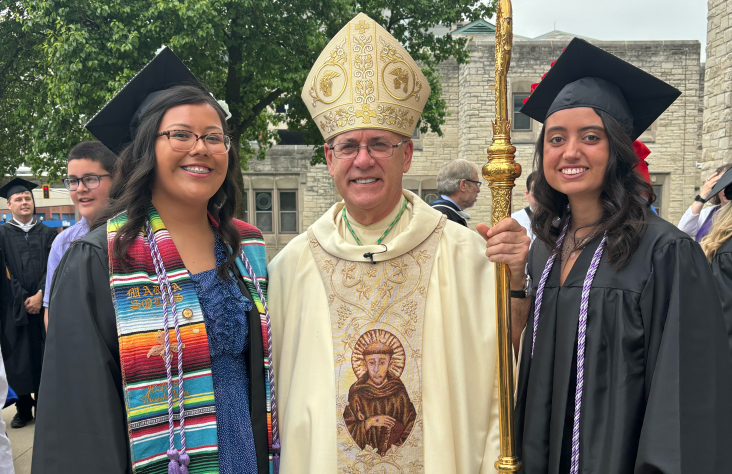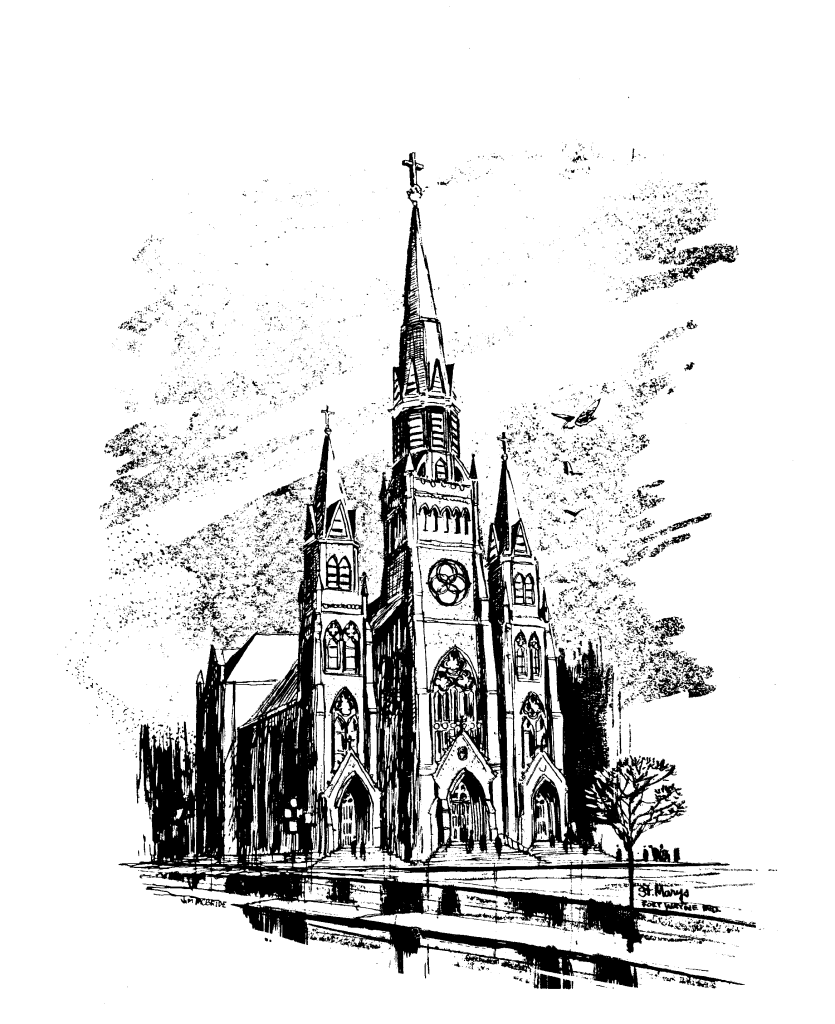September 5, 2023 // Diocese
30 Years Later: Remembering the Fire at St. Mary
Rain and lightning came down. Fire and smoke went up.
So went the demise of the physical structure of St. Mary Mother of God Catholic Church in downtown Fort Wayne on September 2, 1993. Remembering the 30th anniversary of the inferno this year, the parish, now stronger, continues its work in the community and in the hearts of parishioners.
The Church
According to a 2013 article in the Fort Wayne News-Sentinel, 30 German families bought the property at the corner of Lafayette Street and East Jefferson Boulevard for $1,700 in 1848. Andrea Thomas, parishioner of the church at the time of the fire, and President and Chairperson for their History Committee, said five chartering families went as far as to mortgage their farms for the endeavor. She also said the people of the new church began at St. Augustine’s, which originally became the Cathedral of the Immaculate Conception nearby. The church was the first German-speaking in the area and, according to the St. Mary website, was 32-by-64 feet in size.
Ten years later, for $30,000, a new church was built and the old one converted into a school. That building was destroyed in 1886 when the boiler exploded, killing a 13-year-old passerby and the custodian, Anton Evans. On December 11, 1887, a new church building was dedicated – the very structure that burned in the 1993 fire. The $75,000 building was Gothic Revival in style and had two spires at 128 feet in height that flanked a 238-foot main tower between them.
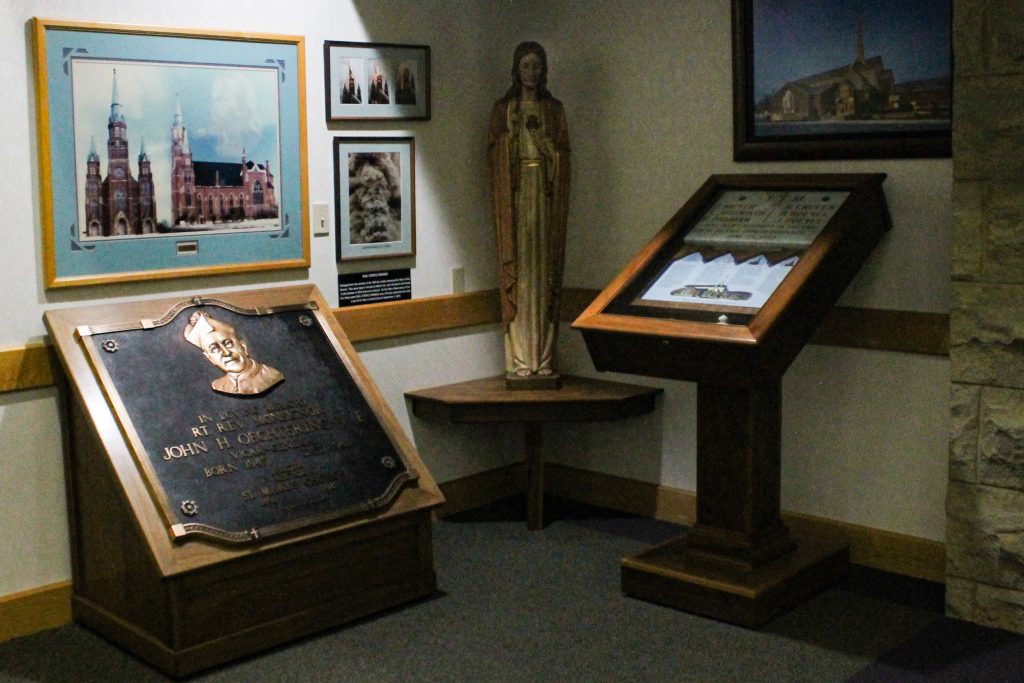
Photos by Bethany Beebe
In Oechtering Hall in St. Mary Mother of God Church, a display that includes images of the fire was created to remember the old church building. The exhibit also includes newspaper coverage from the fire. Another display in the church remembers Father Tom O’Connor, who oversaw the construction of the current structures.
The Day’s Events
Andrea Thomas said Father Tom O’Connor received a security alert that there was a fire recorded by a sensor. On hearing this report, he ran to the church from the rectory, through the breezeway, and into the church, where the choir loft was in flames. She said the lighting strike had traveled down the center steeple, igniting the choir loft and the 108-year-old oak beams running between the roof and the interior ceiling.
“I don’t know that anything could have saved it,” Thomas said.
Reported at 2:21 p.m. and officially declared under control at 5:43 p.m., 10 pieces of fire equipment and about 50 firefighters waged war on the inferno.
Mimi Wismer, a private firefighter at the time, recalls being among the first firefighters to enter the blaze. She said in a video offered by the News-Sentinel that to help assess how far a crew should advance to fight flames, water is sprayed ahead of the entering first responders. When the water flows back down on the people doing the spraying, they know it is cool enough to proceed. In the case of the fire at St. Mary, though, entering water turned directly to steam in the extreme heat of the blaze. They had to turn back because the fire had engulfed the building so completely; it was so hot that the plaster on the ceiling began to crumble and fall.
“We tried our best to get as much out of the church as we could,” she said in the video. “We knew it was probably going to be a loss at that point.”
“Once the steeple fell and the roof collapsed, there wasn’t a whole lot for us to do,” said Robert Rainbow, another firefighter. Firefighter Dennis Gear said the windows could not be broken; a clear, supportive material protected the stained glass, and they had to wait for it to melt before those portals could be used as entrance points; axes simply bounced when attempts at entrance were made.
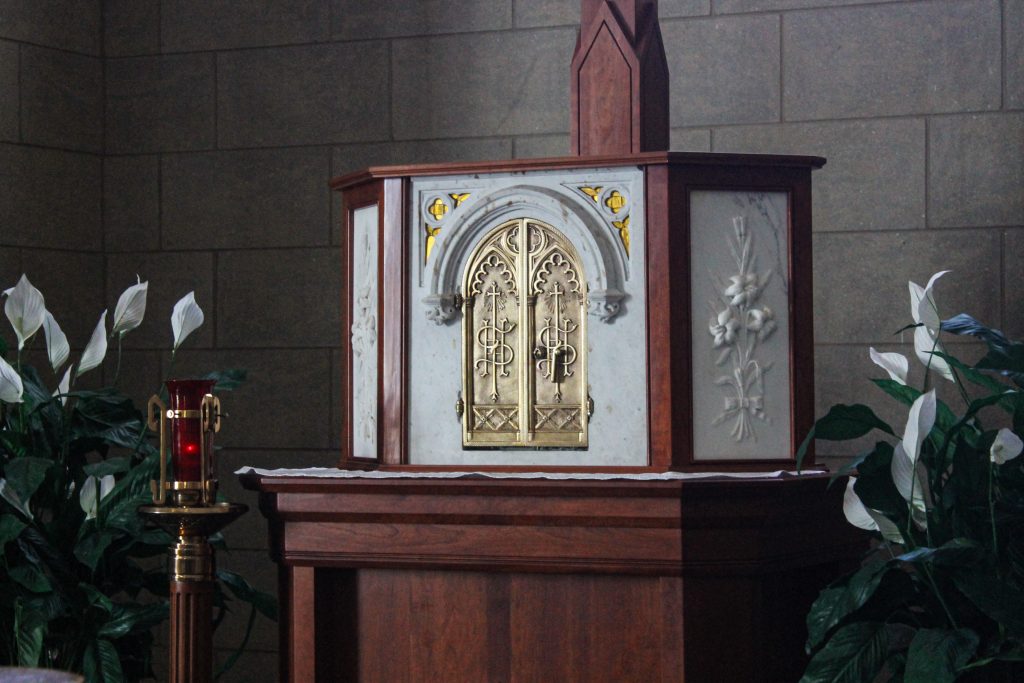
The tabernacle from the old church survived the fire and was refurbished for inclusion in the current church building.
Immediate Aftermath
In the throes of devastation, the people of St. Mary remained focused on their purpose. This past July, Maxine Stoval shared her memories of working with purpose. The day after the fire, September 3, 1993, the soup kitchen still served its guests with a menu of food donated from the Eckrich Company’s Labor Day picnic. In the days that followed, Thomas said, because the parish wanted to continue caring for the hungry, canned goods were distributed from the breezeway. Large outdoor heaters were set up to warm those who came up the rectory
stairs where they normally were given soup and bread. Thomas said huge quantities of donated canned goods were given out until the old boiler house was ready to function as a soup kitchen. Sunday Mass was not forgotten. With their regular parish in ashes, people sat in the alley and parking lot as Mass was celebrated on a makeshift altar at the rectory, Thomas said.
Those served by St. Mary were not forgotten in the time between the fire and when the current church was built. Thomas said for safety reasons, when the 1886 church was built, the boiler was put in a separate building. That structure was repurposed as the soup kitchen until the state-of-the-art, current soup kitchen was constructed. While they were waiting, a house at the corner of Clay Street and Jefferson Avenue was used for church offices and the soup kitchen. This building was used as the original Matthew 25 Dental Clinic, according to Thomas. She also said Masses for the parish were celebrated at St. Paul’s Catholic Church in the ensuing years until use of the new space was possible.
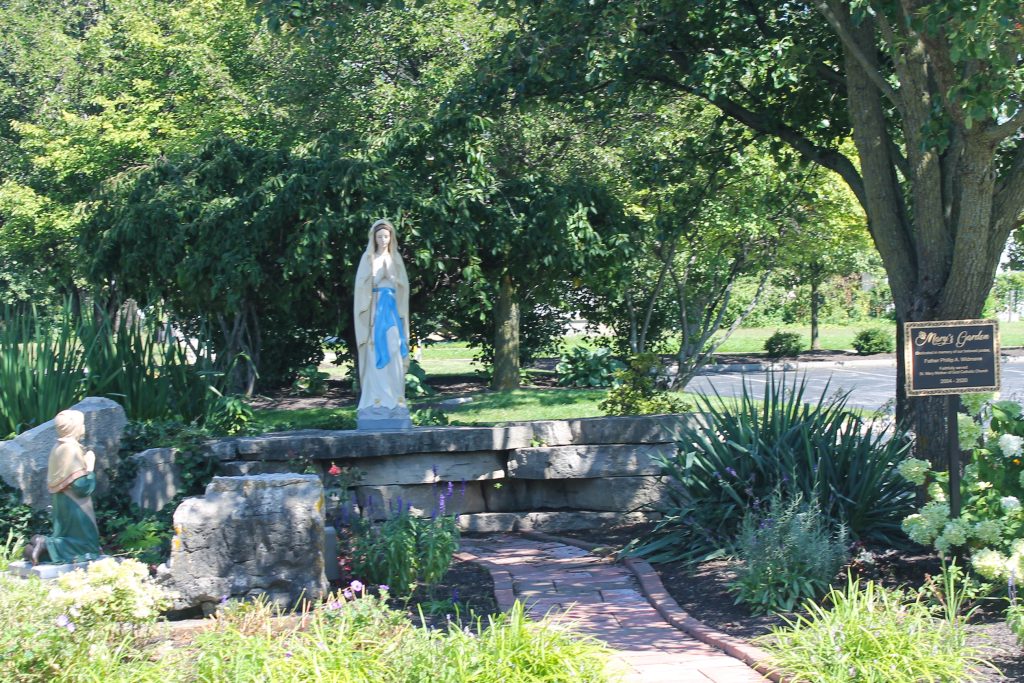
Now in the Mary Garden on the grounds of St. Mary Mother of God in Fort Wayne, this statue of the Blessed Mother survived the devastating fire on September 2, 1993. At the time, the statue of Mary was located in the basement of the church.
Phoenix of the Fire
Careful consideration was put into what would replace the razed structure. On March 29, 1994, then-Bishop John M. D’Arcy made public that Catholic Mutual, the church’s insurance company, settled for $6.6 million. Thomas said half the funds went to construct the current church building and the other half went to the creation of St. Mary’s Heritage Fund, which helps other parishes in the diocese. An additional $290,560 was donated for the rebuild. Bishop D’Arcy said the outcome of the building project would be a smaller but more modern worship building and larger soup kitchen. From May to August of 1994, parishioners were incorporated into strategic planning meetings, eventually resulting in the May 2, 1999, dedication of the current structure, according to the parish website.
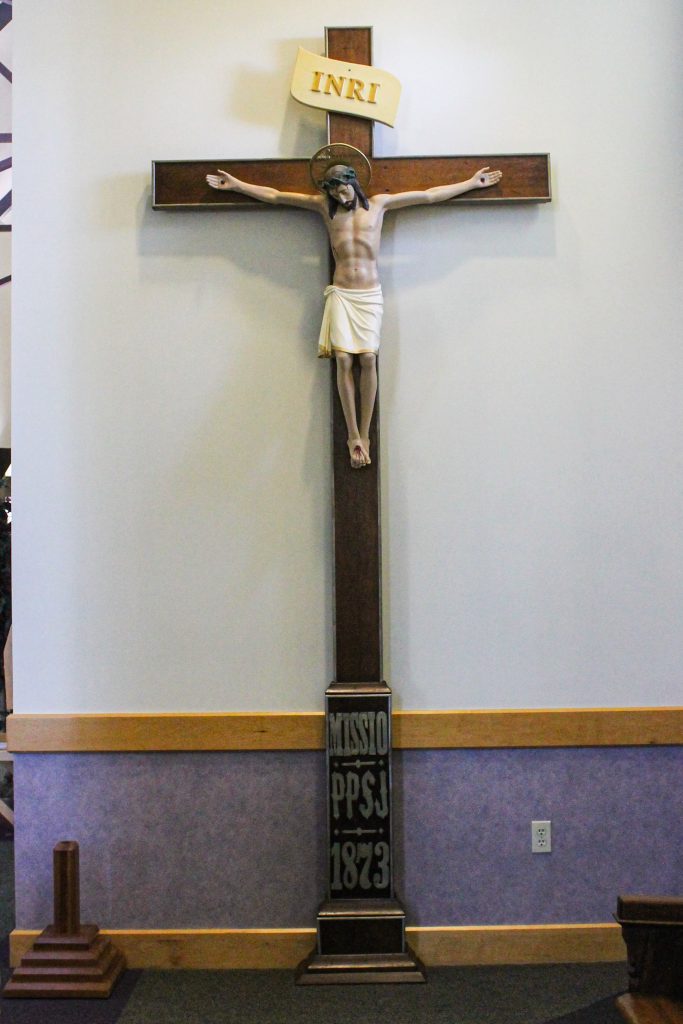
A crucifix that survived both the boiler explosion in 1886 and the 1993 fire stands near the baptismal font in the current church.
Those most intimately involved see some silver lining in the clouds of smoke and disaster. Thomas said the 1886 structure was in need of extensive repair and that the parish had been in talks about what changes might be made to the interior. “We hated to see our old home go,” Thomas said, “but very quickly we knew we … needed to move forward, and that is what we did. … We can’t help but wonder if God made all the remodeling and repair decisions for us.”
Thomas said she and others in the parish acknowledge the disaster but do not let it define them, choosing to look into the future.
Firefighter Mimi Wismer said in her interview with the News-Sentinel: “It was neat to see it rebuilt. Everyone … chipped in and helped do that. … Sometimes after the destruction of something, as sad as that is, it is neat to see the community coming together to rebuild. … I think in the ashes of that, we come together, and I think that is pretty cool.”
St. Mary Parishioners Reflect on Past, Future
It’s been 30 years since St. Mary Mother of God Catholic Church in Fort Wayne burned to the ground. Years later, the community continues to commemorate the event and remains committed to the parish community.
St. Mary parishioner Sue Jehl witnessed the blaze on September 2, 1993.
“I was coming home from work driving toward downtown when I saw the smoke rising above the city and wondered what was on fire,” she told Today’s Catholic. “It soon became clear that it was my beloved St. Mary’s Church.”
For Jehl, the fire had a profound impact.
“Words can’t express how heartbreaking it was to see the place you called your faith home destroyed by fire,” she said.
In commemoration of the 30th anniversary, a special prayer was written encouraging the community to reflect on the event. The prayer acknowledges Mary as the patron of the parish and her impact on its efforts. It also prays for the parish and their mission.
“As our 30th anniversary commemoration prayer notes, ‘Like our ancestors, we are sent forth to live our faith in this world, in this time, and in this place, holding fast to that which is good,’” said Andrea Thomas, a St. Mary parishioner who has completed extensive research on the fire event and the general history of the church.
Like tragedies often do, the fire three decades ago has facilitated further faith among its members and brought the community closer together.
“St. Mary’s has a 175-year history of worship and service, and even though there have been difficult times, like the fire, our shared faith has led us rather quickly to stop cherishing the hurt,” Thomas said.
Even in the fire’s immediate aftermath, the parish community quickly came together.
“On [the Sunday after the fire] we held Mass in the parking lot, and I knew from the love that was on display there that our church was not destroyed and another structure would rise from the ashes,” Jehl said.
And while reflecting is important, the parish understands that it must continue to act. Both the immediate parish community and those who rely on the parish’s soup kitchen have continued to grow and thrive.
Thomas said: “There are liturgies and sacraments to be celebrated, soup to be made, and people to care for.”
– Claire Kenney
The best news. Delivered to your inbox.
Subscribe to our mailing list today.

